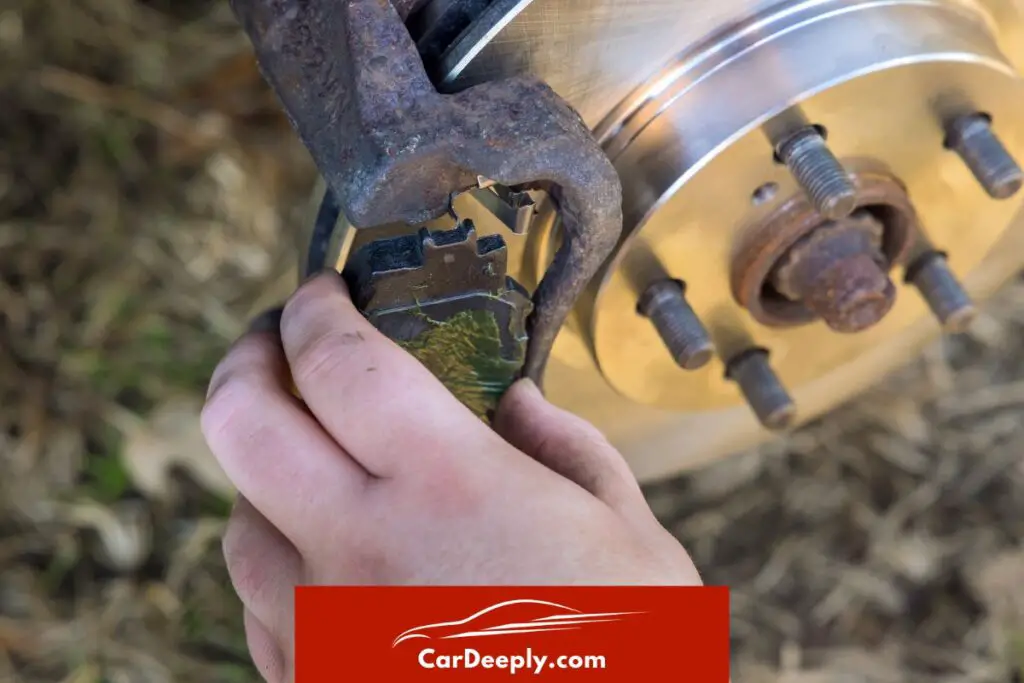Have you ever wondered how frequently the brake pads on a Ford F-150 need to be changed?
It mainly depends on the terrain and your driving style. Most brake pads last between 30,000 and 40,000 miles. Your brake pads may last longer if you often drive smoothly on highways.
On the other hand, brake pad life can be shortened by pulling big loads and using the brakes often.
All in all, everyone should check their brake pads and make sure that they are in good condition.
In this article, please find out how to check your brake pads in F-150 and ensure they are in perfect condition for your driving adventures.
Advertising links are marked with *. We receive a small commission on sales, nothing changes for you.
Checking F-150 Brake Pads: Key Takeaways

You can see that you need new brake pads by:
- recognizing the symptoms of bad brake pads,
- checking brake pads by removing the wheel, and
- checking brake pads without removing the wheel.
How To Check If Brake Pads Are Good? 3 Ways
If you were wondering how to check your brake pads in F-150, can you check the brake pads without removing the wheel, or is there no other way?
All that plus more you will find out if you keep reading! Let’s dig in together and check your brake pads!
#1 Recognize the Symptoms of Bad Brake Pads
The first and easiest way to see if your brake pads are gone bad is to keep an open eye for the usual symptoms of bad brake pads in F-150.
Brakes Are Squeaking or Squealing
The first sign that your brake pads are getting near the end of their usable life is a squeaking or screaming sound emanating from the brakes. Overly worn-down brake pads are frequently to blame for squealing.
You will hear a grinding sound after your pads have worn down enough. Unfortunately, at this point, you will also begin to damage your rotors, increasing the repair cost.
When Braking, You Hear Grinding Noise
As previously said, your brake pads must be replaced immediately if you hear grinding noises when pressing the brake pedal.
Some brake pads come equipped with metal wear indicators that emit a loud noise to let you know when it’s time to change the brake pads.
You risk more significant damage and more expensive repairs if you allow the brake pads to continue grinding.
Braking Causes Vibration
When you press the brake pedal and your car shakes, that indicates a problem with the brakes. The brakes are likely working unevenly since the rotors that aid in stopping the automobile are no longer smooth.
To get your automobile fixed, you need to take it to a specialist.
Taking More Time To Brake
Loss of performance when applying the brakes is another important indication that your brakes need to be examined. For example, it might be a sign that your brake pads are worn out or that your brake fluid is low (typically due to a leak) if you notice less-than-ideal stopping distances while applying the brakes.
It would be best if you visited a professional as soon as possible to guarantee that you maintain all braking capabilities and to obtain complete knowledge of what is happening with your brakes.
The Brake Pad Indicator Light is On
Most current cars come equipped with brake warning lights on the dashboard. Your brake system warning light is the other, and the first is your Antilock Braking System (ABS) light.
Your brake light won’t always come on when something is wrong; it also applies when you apply the parking brake.
However, if your parking brake isn’t engaged and you’re seeing a warning light, it’s time to have a brake specialist examine your system to determine the source of your problems.
#2 Inspect Brake Pads Without Removing The Wheel
The brake pad can be seen through the wheel holes in many cars.
To assess its lifespan, you must ascertain the brake pad’s thickness. To see the brake pad clearly, you might need a torch.
It’s time to acquire new pads if the old ones appear thin, are less than 4 millimeters thick, or only have 20% of their original life left. So, if you wondered at what thickness you should replace your brake pads, now you know the answer.
You could see a metal wear indication tab running the length of certain brake pads. It’s time to replace brake pads if the tab is broken, almost touching the rotor, or both.
#3 Inspect Brake Pads By Removing The Wheel
You wondered if you could check your brake pads without removing the wheel – yes, you can, as shown previously. However, this might be the best way to ensure the status of your brake pads since you will have the best visualization.
Also, you’ll need to remove the wheel to look closer if you can’t see the brake pad through it.
With your automobile parked on a level surface, set your jack underneath the vehicle chassis next to the tire you want to remove. Lift your car up by about 6 inches, then take off the lug nuts and tire.
The caliper, rotor, brake lines, and brake pad will all be visible once the tire has been removed.
Check the brake pad closely for signs of excessive wear. It’s time to book a brake appointment if you see that the pad is than 4 millimeters thick or only has 20% of its original life left.
Frequently Asked Questions
There is more to know when it comes to brake pads, and that is why you should definitely read the next couple of paragraphs.
How to Check What Brake Pads I Need?
You’ll require a certain kind of brake pad depending on your driving habits and road conditions.
For instance, brake pads made for commuter vehicles shouldn’t frequently encounter high temperatures, but those made for high-performance automobiles would need to tolerate some hot bite.
How To Check Brake Fluid In Ford F-150?
Step 1 is to park your F-150 on a flat surface.
Step 2 is to see the brake fluid level in relation to the reservoir’s MIN and MAX markers by looking at the brake fluid reservoir.
The braking system may be impacted if the brake fluid level is below the MIN mark or over the MAX mark on the brake fluid reservoir.
Lastly, just a quick tip: The reservoir cap must always be in place and utterly tight unless fluid is added to prevent contamination.

Luna Meschiari is a full-blooded car nut who is well known to local garages, as each article is meticulously researched and peppered with the latest piece of information. Guess what car she’s driving right now? A RAV4 2021 Hybrid. But her heart also sleeps for pickups like the F-150. Get to know Luna better on the about us page.
Advertising links are marked with *. We receive a small commission on sales, nothing changes for you.
